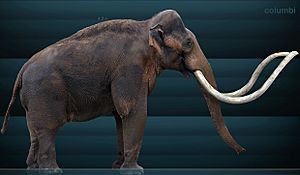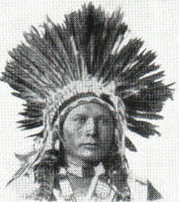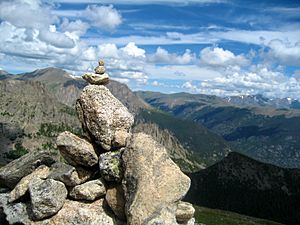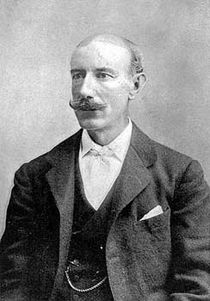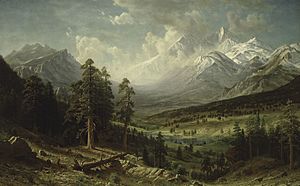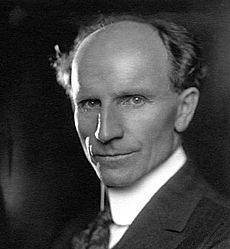History of Rocky Mountain National Park facts for kids
The Rocky Mountain National Park has a long and exciting history! It all started when early people, called Paleo-Indians, traveled through the area to hunt and find food. Later, the Ute and Arapaho tribes also hunted and camped here.
In 1820, an explorer named Stephen Harriman Long led an expedition near the Rockies. A famous mountain, Longs Peak, is named after him! Settlers began arriving in the mid-1800s. Many Native Americans moved away by 1860, and others were later moved to special areas called reservations.
Mining towns like Lulu City and Dutchtown popped up in the 1870s as people searched for gold and silver. But the mining boom ended by 1883. Travel to the area became easier when the railroad reached Lyons, Colorado in 1881 and the Big Thompson Canyon Road was finished in 1904. The 1920s brought a lot of building, including the amazing Trail Ridge Road, which was completed by 1938.
Many people worked hard to create the national park, including Enos Mills from Estes Park. Finally, Rocky Mountain National Park was officially created on January 26, 1915!
Contents
Early History of the Park
Ancient Hunters: Paleo-Indians
People have been visiting the area that is now Rocky Mountain National Park for at least 11,000 years! Early hunters, called Paleo-Indians, used special stone tools to hunt huge, now-extinct animals like Mammoths and ancient bison. They traveled through the park on a path that is now Trail Ridge Road.
These early people lived in animal hide tents or brush huts. About 8,000 years ago, they started hunting smaller, modern bison and gathering food like roots and berries. Archeologists have found their tools in many places across the park, showing that people visited often, especially for hunting. They didn't usually live in the mountains during the cold winters.
About 3,850 to 3,400 years before Christ, people built long, low stone walls, sometimes hundreds of feet long. These were called game drive systems. Hunters used these walls to guide animals like bison, sheep, deer, or elk towards other hunters waiting with spears or darts. Up to 25 people might have worked together for a successful hunt!
By 400 to 650 A.D., people started using bows and arrows for hunting. They also made pottery. These early people continued to use game drives until about 1000 A.D.
Native American Tribes
Between 1000 and 1300 A.D., the Ute people moved into the Rocky Mountain area. They were hunter-gatherers who traveled in small family groups. They stayed in the park area during the summer and in Estes Park for the winter. They ate bison, elk, bighorn sheep, and berries. They used dogs to help carry their belongings.
In the early 1800s, the northern Arapaho tribe also came to the Rocky Mountain regions. They looked for tall trees for their tepees in the Kawuneeche Valley. They also spent time in Estes Park and nearby areas. The Arapaho had special names for many places in the park, often based on animals or events. The Arapaho left the area before 1860 when more European settlers arrived. By 1878, the northern Arapaho were moved to a reservation.
The Ute and Arapaho people used three main trails to travel between Middle Park and Estes Park. One trail, now called Fall River Trail, was known as Dog Trail because dogs pulled sleds over the snow. Another, Child's Trail (now Ute Trail and Trail Ridge Road), was so steep that children had to get off their horses. Big Trail went over Flattop Mountain and was used by fast warriors. Both tribes used stone piles called cairns to mark their trails.
Many places in the park show signs of Native American visits, like tepee rings and summer camps. Tools made of stone and bone have been found, used for hunting, preparing food, and working with animal hides. Native Americans also carried rocks to the top of Oldman Mountain for special ceremonies called vision quests.
Other tribes like the Apache, Cheyenne, Sioux, Shoshone, and Comanche also sometimes hunted or visited the area.
Explorers and Early Settlers
Not much is known about Europeans who might have visited the Rocky Mountain National Park area before the 1800s. French fur trappers came in the 1700s and traded firearms with Native Americans. Some French trappers even called Longs Peak and Mount Meeker "Les Deux Oreilles," meaning "two ears," in 1799.
American fur trappers arrived in the early 1800s. One trapper, James Pursley, even found gold in 1805! Joseph Bijeau, who later guided the Long expedition, lived and trapped in the Rockies for six years.
The Long Expedition
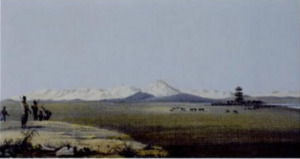
In 1819, Stephen Harriman Long of the U.S. Army led an expedition to explore the western frontier. His team traveled west from the plains, following the South Fork of the Platte River. On June 30, 1820, they saw what Long called the "highest peak" on the horizon. By 1825, this mountain was named Longs Peak on maps.
Rufus B. Sage's Visit
Rufus B. Sage is thought to be the first white man to enter Estes Park in September 1843. He hunted there for a month and described the area as beautiful, with "meandering watercourses" and "vast piles of mountains climbing beyond clouds." At that time, Ute and Arapaho people lived there. Sage wrote about his adventures in a book, Rocky Mountain Life, which was one of the first descriptions of the fur trapper's life in the area.
After the Mexican-American War (1846–1848) and during the gold rush, more people started traveling west to the Rockies.
Joel Estes and His Family
We stood on the mountain looking down at the headwaters of Little Thompson Creek, where the Park spread out before us. No words can describe our surprise, wonder and joy at beholding such an unexpected sight.
In October 1859, Joel Estes and his son Milton were hunting when they found a beautiful area where they saw "no signs that white men had ever been there before us." In 1860, Joel Estes moved his family to two cabins he built at the edge of the park. He brought his cattle to graze in the green pastures and hunted deer and elk, selling the meat and hides in Denver.
The American Civil War started in 1861. During a trip to Missouri, Joel Estes freed his slaves. In 1865, Charles F. Estes, Joel's grandson, was the first white child born in the park. However, the winters were too harsh, and Joel Estes left the area in 1866.
Later, Griff Evans moved into the Estes cabin and improved it. In 1926, the town of Estes Park put up a plaque to remember the Estes family at the cabin site.
William Byers and Longs Peak
William Byers, who was the editor of the Rocky Mountain News newspaper, visited Estes Park in 1864. He tried to climb Longs Peak but couldn't find a way to the top, so he climbed Mount Meeker instead. His newspaper articles about his visit led to the area being named Estes Valley. In 1868, Byers, John Wesley Powell, and five other men made the first recorded climb to the top of Longs Peak.
Joseph Wescott at Grand Lake
Joseph Wescott moved to Grand Lake in the late 1860s, hoping the hot springs nearby would help his rheumatism. He built a cabin and hunted and fished. In the winter of 1867, the snow was so deep that he ran out of food. He even boiled leather from a chair and his shoes to survive! A hunting party later saved him. Wescott was the first person to live in the Grand Lake area permanently.
Before Wescott, Philip Crenshaw built a cabin in 1858 and trapped animals for fur. By 1868, tourists started coming to Grand Lake.
Growth of Estes Park
Estes Park became a popular tourist town in the 1870s. Writers like Byers published stories about the area's great hunting, fishing, and beautiful scenery, which encouraged more people to visit. Frederick H. Chapin explored the area and wrote a book called Mountaineering in Colorado in 1889. A mountain in the Mummy Range is named after him.
People who moved to the area worked in mining, ranching, and lodging. Some also worked in the lumber industry, with sawmills operating near Bierstadt Lake and Hidden Valley.
Mining Rush in the Never Summer Mountains
Towns like Lulu City, Dutchtown, and Gaskill were created in the Never Summer Mountains in the 1870s. People came hoping to find gold and silver. Lulu City once had 40 houses and a hotel. However, the amount of gold and silver found was too small to be profitable. The mining boom ended by December 1883, and miners left their claims. Dutchtown was abandoned by 1884.
Lord Dunraven's Land
Windham Wyndham-Quin, 4th Earl of Dunraven and Mount-Earl, a famous hunter, first visited the area in 1872 to hunt elk. Two years later, he decided to buy 8,000 acres of land to create a private hunting area or cattle ranch. He used a tricky plan where people would claim small pieces of land and then sell them to him cheaply.
Locals were very angry about Dunraven's land grab. Realizing his private hunting area wouldn't work, Dunraven created a game park and hunting lodge north of Estes Park. He also started a cattle ranch called the "English Dairy" with Swiss cattle. In July 1877, Dunraven opened the Estes Park Hotel. He visited the area for the last time in the mid-1880s and sold most of his land in 1908 to F.O. Stanley and B.D. Sanborn.
Albert Bierstadt's Art
Albert Bierstadt, a famous painter, was asked by Lord Dunraven in 1876 to create a very large painting of Longs Peak and Estes Park. He traveled around the area, making sketches and paintings. He was especially interested in a lake, which is now called Bierstadt Lake. An early historian said that Bierstadt's favorite spot for sketching was on the shore of this lake. Bierstadt's painting of the lake is now in the Denver Art Museum.
Creating a National Park
It became easier to reach Estes Park when the Denver, Utah and Pacific Railroad arrived in Lyons, Colorado, in 1881. The Big Thompson Canyon Road was finished in 1904. By 1907, car services offered rides to Estes Park from Loveland.
The idea of creating a national park in the Rocky Mountains of Colorado finally came true in 1915. This happened because many people worked together for many years. Key people included Enos Mills from Estes Park, James Grafton Rogers from Denver, and J. Horace McFarland from Pennsylvania. Each of them played an important part.
Enos Mills' Efforts
Enos Mills moved to Estes Park in 1884 when he was 14 years old. He explored the mountains and wrote many books and articles about the area. Mills owned a resort, loved nature, and worked to protect it. In 1909, he suggested the idea of an "Estes National Park." Local business owners quickly supported him. He wrote articles for popular magazines and books, telling people about the beauty of Colorado's Rocky Mountain region. Mills also traveled the country, giving talks and gathering support from important friends.
Arapaho Place Names
In 1914, the Colorado Geographical Society arranged for two Arapaho elders to return to the park. They shared the Arapaho names for places before the U.S. Geological Society printed maps of the park. Some places in the park that still have Native American names include Nokhu Crags ("rocks where the eagles nest"), Kawuneechee ("coyote") Valley, and Mount Neota ("mountain sheep's heart").
The Park is Born!
The bill to create the park passed Congress and was signed by President Woodrow Wilson on January 26, 1915. A special ceremony was held on September 4, 1915, in Horseshoe Park. Over the years, the park has grown, with the largest addition, the Never Summer Range, added in 1929.
Developing the National Park
The 1920s saw a lot of building in the park, including lodges and roads. The most famous was Trail Ridge Road, which was built between 1929 and 1938. During the Great Depression, the Civilian Conservation Corps helped with many building projects. You can still find parts of their old camps in the park today.
Rocky Mountain National Park was also a place for downhill skiing. Hidden Valley (Ski Estes Park) was a ski area that operated from 1955 to 1991. Locals had skied there long before it became an official ski area.
Agnes Vaille's Story
Not everyone who climbs Longs Peak makes it back safely. There is a stone memorial at the Keyhole formation for Agnes Vaille, a well-known climber from the 1920s. In January 1925, Vaille fell 100 feet while climbing down the North Face. She survived the fall with minor injuries but couldn't walk. Her climbing partner went for help, but when rescuers arrived, Vaille had died from being tired and very cold. Sadly, one of the rescuers also died trying to save her.
Environmental Events in the 21st Century
On June 24, 2010, a wildfire burned over 1,500 acres of the park near Estes Park. Firefighters believed that lightning might have started the fire.
In September 2013, the park and the town of Estes Park were badly damaged by a huge rainstorm. The park was closed to visitors for a week. All roads leading to the park from the east were closed for days or even weeks. At one point, the only way to leave Estes Park was by using Trail Ridge Road, which leads to Grand Lake on the western side of the park. The biggest damage inside the park was in the Alluvial Fan area, where floodwaters, rocks, and debris washed away parking lots and much of Fall River Road. After repairs, the road reopened on July 2, 2015.
|


